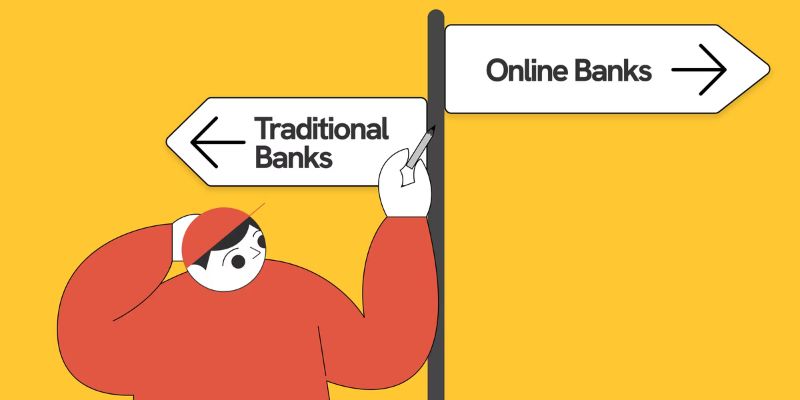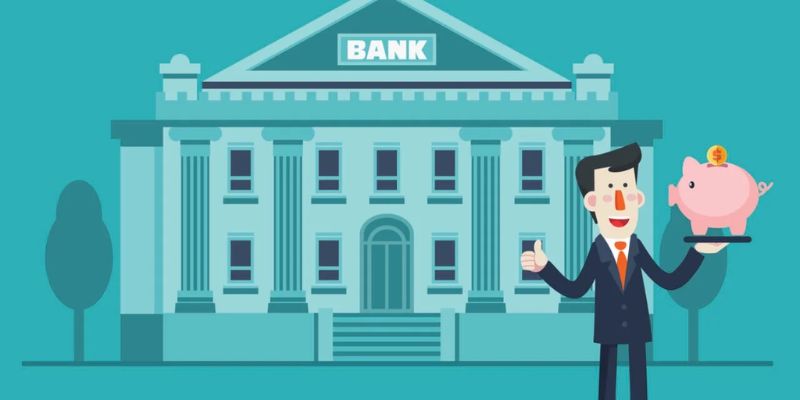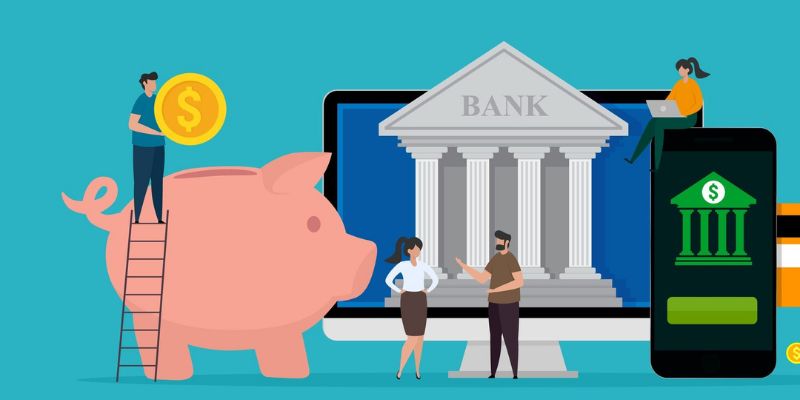Choosing between online banking vs traditional banking can shape your financial journey. On one hand, you have the ease of digital transactions. On the other, the solid feel of walking into a branch and chatting with a teller. Let’s break it down. Ever found yourself weighing convenience against personal touch? Or security versus cutting-edge tech? Every choice nudges your finances in a certain direction, and I’m here to guide you through these paths. Stick with me as we explore which banking style not only fits your lifestyle but also boosts your financial health. Get ready to uncover whether online wizardry or traditional tactics win out for managing your money.
Understanding Digital Banking: Convenience and Innovation at Your Fingertips
The Rise of Web-Based Financial Services
Web-based financial services are taking off. More folks enjoy banking right from their homes. They no longer need to visit a bank and wait in lines. With just a click, money moves swiftly. That’s digital banking for you. It blends tech and finance, making life easier for users.
Mobile Banking Features and Online Account Management
Let’s talk about mobile banking features. Things like checking accounts online are super. You can peek at your balance, send money, and pay bills—all on your phone. Isn’t that a breeze? With online account management, you’re in control. Forget about bank operating hours. Your bank lives in your pocket now, thanks to bank mobile apps.
Online loan applications are easy peezy. Fill in some details, and bam, you’re done. No more paper forms! Digital wallets store your card info securely. So, when it’s time to shop, shopping is a snap.
Knowing your money is safe matters a lot. Cybersecurity in banking keeps your cash and info locked down. With good internet banking security protocols, your fears can take a back seat. Your online transactions are protected. Even if you drop your phone, no one can touch your cash!
Here’s the kicker. You can do all your banking without ever seeing a bank! Branchless banking models are fresh and cool. Online savings accounts often offer better bank interest rates than the old-school ones. Plus, when using digital payment systems, your cash travels at light speed.
But wait, there’s more. Online banks often charge lower fees. Check out bank fees comparison sites. You’ll see for yourself. Electronic fund transfers zip money across the globe in no time.
Got a check to deposit? Snap a pic with your phone. That’s remote deposit capture. It’s that simple. No need to jog to an ATM.
And who likes paperwork? With digital banking benefits like online banking automation, say bye to stacks of paper. Your banking is cleaner and greener.
Financial technology advancements keep surprising us. Real-time banking transactions mean you see where your money is going, as it happens. It makes online money management tools rock stars. You’re the boss of your bucks, always.
Digital banking convenience shines. It fits your busy days. But are you thinking, “I miss talking to folks at my bank?” We get it. Yet many banks now offer solid online customer service. So, you still get help when you need it.
See, with a combo of tech and smarty features, digital banking is like a superhero for your wallet. It zips in to save your day with fast, safe, and smart banking powers. Whether you’re chilling at home or out with friends, your bank is just a tap away. Isn’t that something we all could use?

The Role of Traditional Banking: Personalized Service and Physical Accessibility
The Value of Face-to-Face Financial Advice
Meeting someone who knows banking inside out can change your money game. In a bank, you can chat, ask questions, and get solid advice. Imagine needing help figuring out a home loan. You walk into your local branch, sit down with a friendly expert, and they walk you through the whole thing. It’s personal. It’s direct. And it’s all about you.
Traditional Teller Services and ATM Banking
Remember the last time you had to cash a check? You might have gone to a bank teller. They’re the face of the bank – always ready to help with deposits, withdrawals, or any cash service you need. Now, let’s talk about ATMs. They’re like mini banks, open around the clock, all days of the week. Need cash fast? Find an ATM. Need to deposit a check? The ATM’s got you.
With bank branches, you can find one close to where you live or work. That’s handy! They have set hours, but ATMs and some teller services are there even when the branch doors close. And face-to-face help means you walk away knowing exactly what’s happening with your money.
As a digital banking expert, I keep my eyes on how banks use tech to make life easier. Things like bank mobile apps and online loan applications are big wins. But I know that people value that personal banking experience. And get this; even with all the digital wallets and online money management tools, many still prefer a good ol’ chat with their bank advisor. They believe in the power of that human touch.
Brick-and-mortar bank branches keep offering these valued services despite the rise of web-based options. Even with the convenience of online transactions, folks trust the tellers they’ve known for years. That’s something tech just can’t replace. Sure, internet banking has its perks. Quick transfers, checking accounts online, and real-time updates are great. But the personal touch you find in traditional banking – there’s your gold.
So, when you think about your finances, consider the balance. There’s room for the swift, easy nature of digital banking benefits and the warm, familiar feel of walking into your local branch. It’s not about one being better than the other; it’s about them working together for you.
With every tap on a bank app and every visit to a teller or ATM, you’re the one in control. Want to go modern with internet banking security protocols and electronic fund transfers? Go for it! Prefer a handshake and a chat as you sort out your savings and checking accounts? The bank doors are open. It’s all about finding the mix that fits your life.
You’re here to make smart money moves. Whether that’s using digital banking convenience or counting on traditional teller services, it’s your choice. So think about what you need, what makes you comfortable, and what will help you grow your finances. Your money, your way – that’s the real win.

Security in Banking: Comparing Online Versus Brick-and-Mortar Protections
Cybersecurity in Banking and Internet Banking Security Protocols
You lock your doors, right? Think of cybersecurity the same way, but for your money. Online banks know this and work hard to keep your cash safe. They use tough security measures that you, as a user, see as passwords or security questions. But behind the scenes, it’s way more complex. Banks use encoded messages that keep thieves out, just like locks keep burglars out of your home.
The big question is, is online banking safe? Yes, it’s as safe as traditional banks. Banks on the web guard your money using Internet banking security protocols. This means they follow special rules to keep your info out of the wrong hands. Every time you log in or pay someone, banks check to make sure it’s really you. They might send codes to your phone or use your fingerprint. This is how they keep sneaky people from breaking into your account.
Think about when you go shopping. Maybe you use your phone to pay. Those phone payments use digital wallets. They have super security to protect your card details. Is this safer than ATM banking? Well, with ATMs, there’s a risk of someone spying on your pin code. With digital wallets, your info gets scrambled. Scrambled info is harder for thieves to use.
But hey, banks with real buildings use good old human checking, too. They have cameras and workers. These two watch for anything fishy. Plus, if you have a problem, you can talk face-to-face. That can’t be hacked!
FDIC Insurance Coverage and Traditional Bank Customer Service
Now, what if a bank goes under? Enter FDIC insurance coverage. It’s like a safety net for your money. Both online and brick banks have it. Your money’s insured up to $250,000. So, even if the bank fails, you won’t lose your savings. Online or offline, your money has that security blanket.
And service? Traditional banks let you talk to someone if you bump into trouble. You can get help with your account or get questions answered straight away. Having someone to chat with can make a big difference. It can make you feel more secure. This is what people call the personal banking experience.
Some folks need to know someone’s there to help. And that’s what physical banks are best at. Remember, though, that online banks are always open. No need to watch the clock. You can bank in your PJs if you want!
When it comes to staying safe, both online and regular banks have their pros and cons. It’s about locks and keys in the digital world, and the same goes for the physical one. Your safety net’s always there, with FDIC insurance watching your back. In the end, it’s all about what makes you feel safest and most taken care of.

The Financial Implications of Banking Choices on Your Wallet
Analyzing Bank Fees and Interest Rates: Online vs Offline
What costs more: bank fees for online or for traditional banks? Online banking often has lower fees. That’s because online banks don’t have to pay for physical branches. This means they can save and offer you higher interest rates for savings too.
Now, let’s dive in. You know when you save money, you earn interest, right? Well, with online banking, you might earn more. They have less overhead. This means they use less money to run their biz. So, they pass those savings to you through higher interest rates. But, don’t forget to check if they cover your cash like traditional banks do, with FDIC insurance.
You might ask, “What about checking accounts?” They’re key for day-to-day money stuff. Online, many checking accounts have no fees. Yep, you heard that right. Plus, some even pay you interest. That’s not common with offline bank accounts.
And hey, are you tired of running to the bank during open hours? With online banks, time doesn’t bind you. You log in, move money, or even apply for loans any time. That’s hard to beat!
The Convenience of Online Transactions and Electronic Fund Transfers
How’s moving money easy with online banking? It’s a tap away! You can pay bills, friends, or do shopping with just a few clicks. Think electronic fund transfers (EFTs). They’re quick, often free, and safe.
Let’s break it down. With mobile banking apps, you can check your money fast. Lost your card? Freeze it with the app. Want to deposit a check? Snap a pic and it’s in. Need to send cash to a buddy for pizza last night? Just Zelle them or use another digital wallet. No need to find an ATM.
Now, I get it, some folks like face-to-face service. For big things, like a mortgage, it’s nice to talk to someone. I won’t knock down the value of a good chat. But for most stuff, online banking is a time-saver.
Listen, it’s all about what works for you. You like convenience and handling money at midnight? Go digital. Prefer walking into your bank and chatting with Jim about your dog? Stick to a branch. But, know this, the digital world gives you tools that make money moves easy. And it’s changing how we all think about banking.
Remember, financial tech moves fast. And so can you, with the right online tools. It’s not just the future; it’s your now. Make those smart money choices that’ll keep your wallet happy!
We’ve explored the fast world of digital banking and how it brings banking right to your screen. We dug into how web services and mobile banking change the game. And we took a look at traditional banks, with their personal touch and easy-to-visit ATMs.
We also compared the security of online banking and physical banks. Looks like both guard your cash, but they do it in different ways. And let’s not forget about how banks hit our wallets with fees and interest rates. We saw how going online can make moving your money around easy and sometimes cheaper.
So, what’s the takeaway? Both digital and regular banks have their perks and downsides. Your choice depends on what you value more: innovation and convenience, or the familiar face-to-face service. Think about safety, costs, and ease of access when choosing where to stash your cash. No matter what, you’re now armed with info to make the best choice for your bucks.
Q&A :
What Are the Main Differences Between Online Banking and Traditional Banking?
Online banking typically offers customers the convenience of conducting financial transactions digitally through a website or app, while traditional banking usually involves visiting a physical bank branch. Online banks often have lower fees and higher interest rates on savings accounts due to lower overhead costs, while traditional banks provide in-person customer service and may offer a wider range of services.
How Secure Is Online Banking Compared to Traditional Banking?
Online banking employs advanced encryption, multi-factor authentication, and continuous monitoring to protect users’ data and transactions. Traditional banks also utilize robust security measures but may be more exposed to physical threats like theft or natural disasters. Both banking methods prioritize security but have different vulnerability points to consider.
Can I Access All the Same Features with Online Banking as I Can with Traditional Banking?
Most online banks offer essential banking services such as fund transfers, bill payments, and account management. However, traditional banks may provide additional services such as notary services, safe deposit boxes, and in-person financial advising that online banks can’t match. The accessibility of features will vary by institution, so it’s essential to check with the specific bank.
Is Customer Service Better in Traditional Banking Compared to Online Banking?
Traditional banking typically offers face-to-face customer service, which can be preferred for complex issues or personal preferences. Online banking provides customer support through phone, chat, or email, which can be more convenient but may lack the personal touch. The quality of customer service will depend on the bank’s commitment to customer satisfaction in either setting.
What Happens If an Online Bank or Traditional Bank Goes out of Business?
Both online and traditional banks in the United States are generally insured by the Federal Deposit Insurance Corporation (FDIC) up to $250,000 per depositor, per insured bank, for each account ownership category. If a bank fails, the FDIC protects the insured deposits, and the process for accessing your funds will be guided by the FDIC in either scenario.

